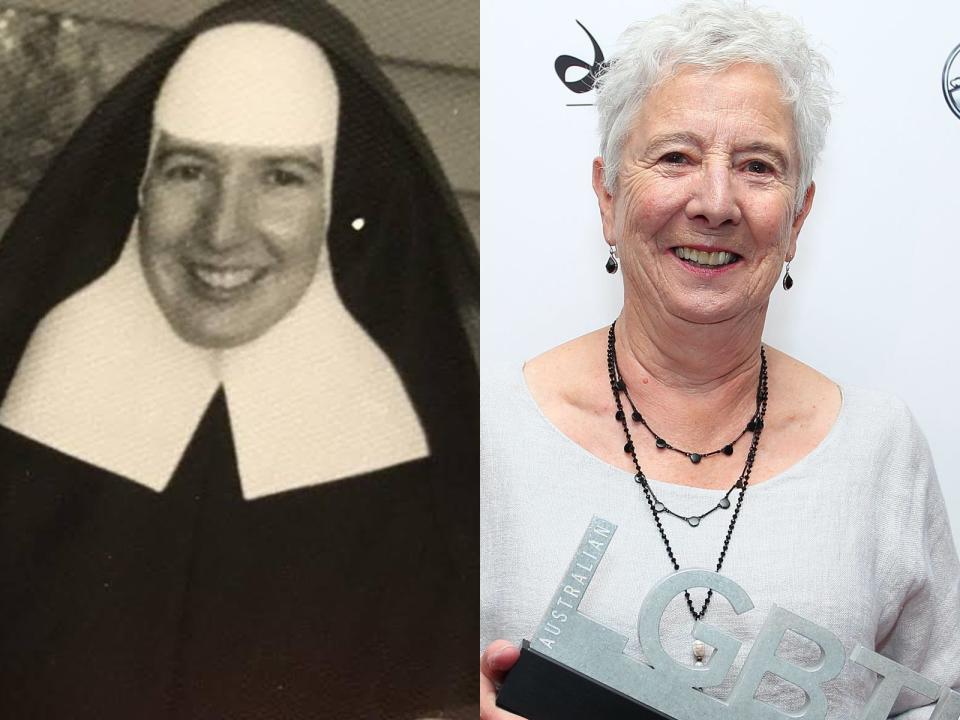I was a nun for 2 decades before leaving the convent to be with a woman. I stood up to the church for our right to love.

Monica Hingston became a nun at 21 but left the convent when she fell in love with another nun.
They moved to a seaside town to live as soulmates — but never got the chance to be spouses.
This is Hingston's story, as told to Gary Nunn.
This as-told-to essay is based on a transcribed conversation with Monica Hingston, who left the convent to enter into a same-sex relationship with a fellow nun. It has been edited for length and clarity.
At 21, I walked down the aisle on my "wedding" day wearing a traditional white dress and a huge train. After I spoke my vows, I walked into a room next to the cathedral. Two women presented me with an austere black gown and asked me to remove my wedding dress. Then they hacked off my hair.
Those two women were nuns. My groom was an unlikely man — Jesus Christ himself.
In 1962, this was known as "the reception" into the convent, and I had just become a nun.
I was an unlikely nun
I'd been a chain-smoking teenager with a motorbike-riding boyfriend, but I came from a religious family. My cousin Cardinal George Pell became one of the most powerful Catholics and the pope's treasurer.
My mother didn't want me to join the convent at all; she thought I was limiting my options in life. My dad, meanwhile, thought it was an honor from God. He had a brother who was a priest.
But I admired the nuns who taught me: They were nonmaterialistic people. They were intelligent, caring, and compassionate women doing good without expecting anything in return. I saw that their lives had value and they aspired to be the best human beings they could be — by helping others.
But being a nun tested my rebellious streak. Once, my cousin observed me teaching girls how to empower themselves. He dismissively accused me of teaching them "nothing but fairy floss." When I was discovered reading a banned philosophy book, a superior said, "Careful. You can read your way out of the church."
Other times, I questioned why we'd have to follow strange instructions, like moving furniture just to demonstrate blind obedience.
After over 2 decades in the convent, I considered leaving the church for good
I took a yearlong sabbatical and hitchhiked around South America. I was later posted in Chile, where I, along with two American nuns, established a center for struggling Chilean women.
One of the other nuns was named Peg. She'd been a nun for 25 years, and I had reached my 21st. We shared a passion for empowering oppressed women. We'd talk for hours. I hated leaving her at the end of each day.
One day, she confessed: "I don't want you to leave, but I'm afraid to ask you to stay."
My entire life changed at that point. Every road had led me to her. I realized I was falling deeply in love, and she felt the same.
We wrote to the pope requesting to be released from our vows, and he swiftly approved
We moved to Torquay, Australia, to live happily as a lesbian couple. There, Peg and I connected on every level. We hugged five or six times a day. We shared our fears and hopes. I'd never known happiness like it.
We wanted to get married — not in a church; by this point, I was firmly an atheist, and Peg was more agnostic. But in 2003, the church instructed Catholic politicians to actively oppose laws recognizing gay unions, calling those seeking them "depraved." My cousin Pell aggressively backed these sentiments.
I wrote him a private letter challenging his homophobia by describing my relationship with my beautiful Peg.
"It is a rare and precious gift. A partnership of sensitivity and selflessness, of warmth and humor, of wonder and beauty," I wrote, adding: "It daily enriches me, it empowers me to work for the wellbeing of others."
A friend persuaded me to make the letter public after Pell ignored me. I reluctantly agreed, hoping it'd help others.
The next day, a man called. He said he'd felt isolated as a gay Catholic and wept at my letter in a newspaper, which made him feel less alone. I was shocked and couldn't wait to tell Peg. I was just so happy to know we'd made a difference.
I received almost 200 similar calls and emails.
Peg and I were soulmates, but we never achieved our dream of marrying
In 2011, Peg was diagnosed with gallbladder cancer. She died three months later at 74. I was 70.
In her final letter to me, Peg wrote, "Owls symbolize intelligence, brilliance, perspective, intuition, quick wit, independence, wisdom, protection, mystery, and power. You are all of these, dearest Mon."
Grief enveloped me. I stopped playing golf and listening to music — everything we loved together. I started living in a fog.
One morning, a year after her death, I heard crows attacking something in a small tree outside my house. I slowly raised my window blinds and froze in shock. It was an owl — a big, beautiful white barn owl with a heart-shaped face. It held my gaze for 15 minutes before flying away.
I finally felt the fog lift. I felt alive — and no longer alone.
Read the original article on Insider

 Yahoo News
Yahoo News 